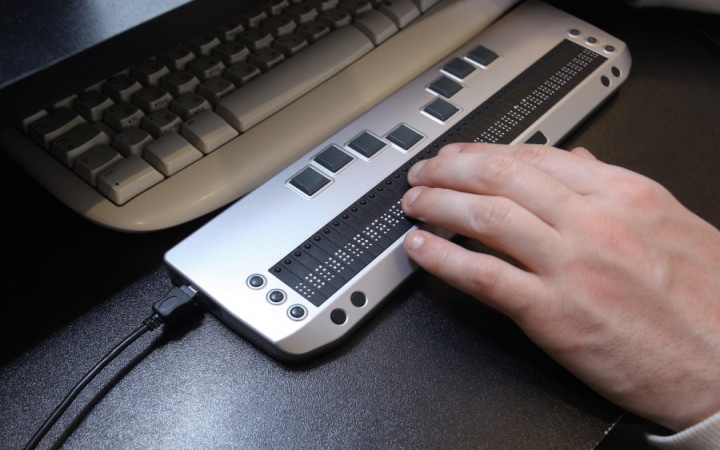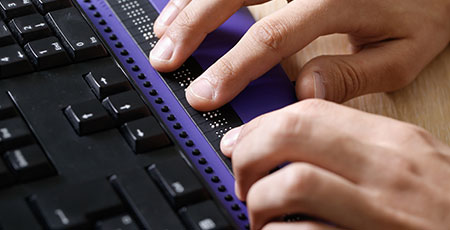Discover Innovative Devices Designed for the Aesthetically Impaired
The development of innovative devices for the visually damaged stands for a considerable improvement in access and self-reliance. Technologies such as wise glasses with AI capabilities and mobile applications made to supply auditory descriptions are improving daily experiences for users. In addition, wearable gadgets that employ haptic responses boost ecological understanding, while modern-day Braille innovations offer brand-new ways to engage with text. As these tools remain to advance, their effect on the lives of those with visual impairments raises essential inquiries regarding the future of inclusivity and freedom in numerous facets of life. What lies in advance in this technological landscape?
Smart Glasses for Navigation

Smart glasses made for navigating are revolutionizing the means visually damaged people communicate with their atmosphere. These advanced tools use a mix of camera modern technology, expert system, and acoustic feedback to offer real-time details regarding surroundings. By using challenge detection systems, smart glasses can notify individuals to potential dangers, enabling much safer movement in both familiar and unknown settings.
The assimilation of GPS modern technology better improves navigating capabilities, permitting customers to get acoustic directions as they move. This hands-free strategy not only cultivates self-reliance but also empowers visually impaired people to navigate metropolitan landscapes with boosted confidence. In addition, numerous wise glasses are outfitted with features that determine landmarks and street indications, offering contextual information that enhances the customer experience.
Furthermore, the development of these devices is continually advancing, with business functioning to enhance the accuracy of object recognition and expand the series of navigational functions. As clever glasses come to be more obtainable and economical, they hold the potential to significantly transform life for visually impaired individuals. Eventually, these innovative tools stand for a crucial step towards inclusivity, offering boosted flexibility and a better feeling of freedom for individuals navigating the world around them.

Mobile Apps for Daily Living
Exactly how can mobile applications enhance the day-to-days live of aesthetically damaged individuals? Mobile apps are reinventing the means aesthetically damaged users navigate their atmospheres, take care of day-to-day tasks, and access info. These applications supply crucial assistance through different performances, cultivating self-reliance and improving lifestyle.
Several cutting-edge mobile applications are made specifically for everyday living. As an example, apps like Be My Eyes connect aesthetically impaired users with sighted volunteers using video clip phone calls, permitting them to obtain real-time aid with jobs such as reading labels or browsing strange areas. In A Similar Way, Seeing AI, created by Microsoft, makes use of expert system to describe surroundings, read text, and determine items, properly changing a smartphone right into an effective device for everyday support.
Furthermore, navigating apps tailored for the aesthetically impaired, such as Aira and BlindSquare, offer audio-based instructions and ecological information, making it possible for users to traverse their environments securely and confidently. Beyond navigation and instant assistance, mobile apps likewise sustain company and job management, with features that help users establish suggestions, develop order of business, and track visits. In recap, mobile applications function as indispensable sources, encouraging visually damaged people to lead more independent and satisfying lives.
Wearable Technologies for Help
Empowerment through technology is significantly noticeable in the world of wearable tools developed to aid visually impaired people. These cutting-edge tools incorporate effortlessly into every day life, boosting navigating and offering important responses to customers. Smart glasses geared up with cameras can check out and recognize faces message aloud, permitting users to engage even more with confidence in social and specialist setups.
One more notable improvement is using haptic responses systems in wearable tools. These systems use vibrations or various other responsive signals to communicate info about the customer's atmosphere, such as challenges or changes in terrain, enhancing wheelchair and security. Wearable modern technologies additionally consist of wristbands that attach to mobile phones, informing individuals to notices via refined vibrations, hence enhancing connection without dependence on visual cues.
As these modern technologies continue to advance, they are not just boosting independence for aesthetically impaired individuals yet additionally fostering a better sense of addition in culture. By linking the void between difficulties dealt with in everyday living and the possibility for freedom, wearable modern technologies function as essential devices in the quest for equal rights and empowerment for those with aesthetic problems.
Sound Summary Devices
Audio summary tools play an important function in enhancing availability for aesthetically damaged people, giving them with the ability to engage with visual media. Wearable technology for low vision. These devices supply narrated summaries of vital visual aspects in movies, television shows, and live efficiencies, making sure that customers can completely comprehend the context and emotions conveyed via visuals
Sound summary can be integrated into numerous platforms, why not check here consisting of streaming solutions, movie theater screenings, and live movie theater. Numerous prominent streaming solutions now include audio description as an access attribute, permitting viewers to pick it conveniently. Along with traditional media, specialized apps also exist, providing audio descriptions for art exhibits, galleries, and other cultural events.
The performance of audio summary pivots on the skill of the storytellers, who must convey aesthetic details succinctly without interfering with the original audio. Advancements in this area are likewise paving the way for more personalized experiences, where individuals can readjust the degree of information and pacing according to their preferences.
Braille Innovations and Devices
Braille innovations and gadgets have actually dramatically transformed the way aesthetically impaired individuals connect with message and information. Modern advancements have led to the development of versatile tools that improve literacy and freedom amongst individuals.
Furthermore, mobile Braille notetakers integrate traditional Braille input with contemporary functionalities, assisting in note-taking, organizing, and file editing on the go. Speech-to-text devices for low vision. These compact tools typically include text-to-speech capacities, linking the void in between Braille and acoustic info
On top of that, cutting-edge Braille printers have arised, allowing customers to generate Braille labels, papers, and instructional products effectively. This accessibility cultivates higher engagement in specialist and academic environments, eventually promoting inclusivity.
In addition, research study into smart Braille innovations remains to expand. Instruments this hyperlink that integrate man-made intelligence are being explored to supply real-time navigating help and contextual info, boosting the individual experience in varied setups. Overall, these advancements reflect a dedication to encouraging aesthetically damaged people with modern technology, ensuring they can conveniently accessibility and involve with the globe around them.

Conclusion
The development of cutting-edge tools for the visually impaired substantially enhances freedom and quality of life. These modern technologies not only foster better inclusion yet also advertise autonomy in daily tasks, eventually contributing to a much more accessible and equitable culture for visually impaired individuals.
As wise glasses end up being extra cost effective and obtainable, they hold the potential to significantly transform daily life for visually impaired gold aviator glasses customers. Mobile apps are transforming the way aesthetically impaired customers browse their atmospheres, handle everyday tasks, and gain access to details. Applications like Be My Eyes connect visually impaired customers with sighted volunteers using video clip calls, permitting them to obtain real-time aid with jobs such as checking out labels or navigating unfamiliar rooms.Furthermore, navigation applications tailored for the visually impaired, such as Aira and BlindSquare, offer audio-based instructions and environmental information, making it possible for users to traverse their environments safely and with confidence.The development of innovative devices for the aesthetically impaired considerably boosts independence and top quality of life.
Comments on “Assistive Technology for the Blind: Tools to Transform Lives”